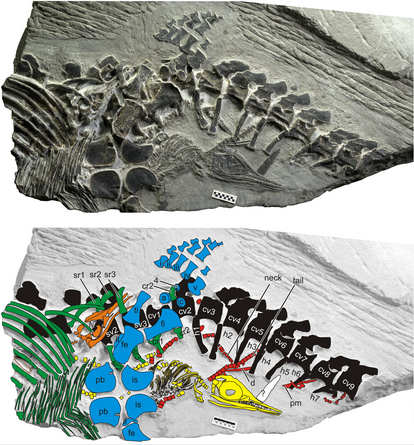248-Million-Year-Old Fossil Shows Oldest Reptile Live Birth, Chaohusaurus Was Born ‘Head First’ [PHOTO]

A 248 million-year-old fossil found in China may show the earliest live birth from a Mesozoic marine reptile.
The findings, published in the journal PLOS ONE, describe the maternal skeleton of a Chaohusaurus that most likely died in labor. The fossil shows a baby ichthyosaur's head that has just exited its mother's pelvis. The female Chaohusaurus was probably giving birth to triplets – one was still inside the mother, the other was in the process of being born and another was already born and lying near the mother.
The latest fossil discovery was made in a laboratory while researchers were investigating a different specimen of a predatory fish.
"The slab was collected for a fish called Saurichthys that was partly exposed in the field. We later realized that there was a Chaohusaurus with babies on the same slab," said Dr. Ryosuke Motani from the University of California, Davis, who undertook the study.
The fossil discovery came as a surprise – not only was the age of the remains significant but the fact the eel-like ichthyosaur did not give birth in the water suggests that reptilian live birth only evolved on land, LiveScience reports.
"Being reptiles, their ancestors lived on land. What happened during the transition from land to the sea is not well understood, and Chaohusaurus holds a key to [unlock] the mystery," Motani told the BBC.
Ichthyosaurs were giant marine reptiles during the age of the dinosaurs. They evolved from land reptiles that moved to the water during the early Triassic period, between 251 million and 247 million years ago. Chaohusaurus belong to the oldest group of ichthyosaurs. While they were known to give birth to their young – as opposed to laying eggs – scientists found older specimens were born tail-first, suggesting the animals gave birth in the water. The latest discovery shows a baby being born headfirst, suggesting the Chaohusaurus was a live-bearing land animal.
"We always assumed that live-bearing in marine reptiles evolved after they invaded the sea, partly because of this difference. Now the new fossil shows that the most primitive marine reptile gave birth head first," Motani said. "This strongly suggests that they inherited live-bearing from their land ancestors."
© Copyright IBTimes 2025. All rights reserved.






















